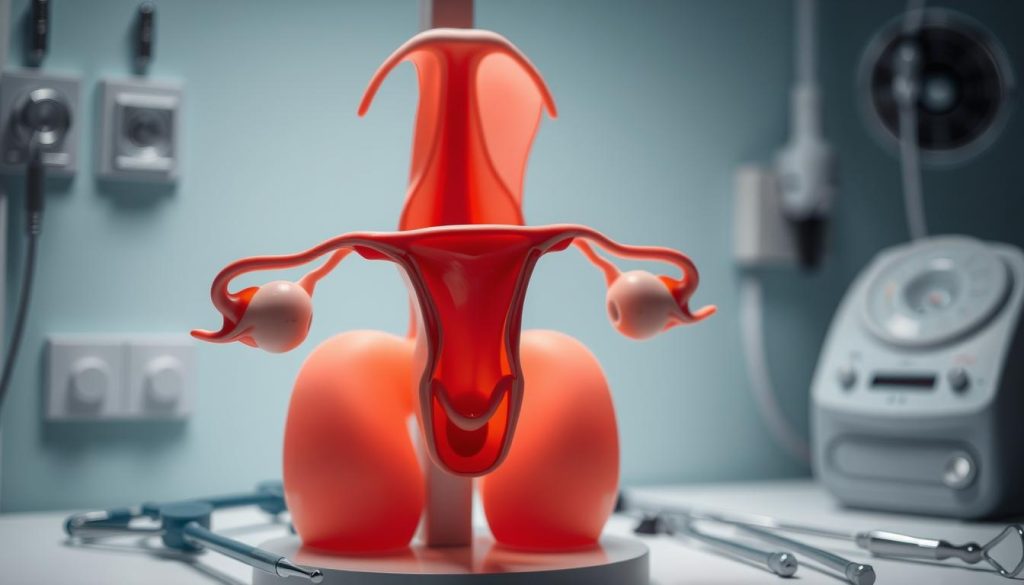Tubes tied surgery, also known as tubal ligation, is a permanent way to prevent pregnancy. It’s a reliable birth control method for women. Tubal ligation works by cutting and tying the fallopian tubes. This stops eggs from reaching the uterus.
Many women choose this surgery if they’re sure they don’t want more kids. It’s a big decision that needs a lot of thought. Knowing the good and bad sides of tubal ligation is key before you decide.
Female sterilization is very effective, with a success rate over 99%. It doesn’t change hormones or menstrual cycles. This makes it a good choice for those who don’t want hormone-based birth control.
We’ll look into the benefits, risks, and what happens during tubes tied surgery. This info will help you understand your reproductive health better.
Understanding Tubes Tied Surgery
Tubes tied surgery, also known as tubal ligation, is a way for women to prevent pregnancy. It blocks the fallopian tubes, making it impossible to get pregnant.
Definition of Tubal Ligation
Tubal ligation is a surgery that seals the fallopian tubes. This stops eggs from reaching the uterus. It’s a reliable way for women who don’t want more children.
How the Procedure Works
A surgeon performs tubal ligation by cutting, tying, or blocking the fallopian tubes. This stops sperm from meeting the egg. The surgery is done through small cuts in the abdomen.
Types of Sterilization Methods
There are different ways to achieve permanent contraception. These include:
- Tubal ligation: Cutting and tying the fallopian tubes
- Fallopian tube removal: Complete removal of the tubes
- Essure: A non-surgical method using coils to block the tubes (no longer available in the US)
| Method | Procedure Type | Recovery Time | Effectiveness |
|---|---|---|---|
| Tubal Ligation | Surgical | 1-2 weeks | 99% |
| Fallopian Tube Removal | Surgical | 2-3 weeks | 99.5% |
| Essure (discontinued) | Non-surgical | 1-2 days | 99.3% |
Each method has its own advantages and disadvantages. Your doctor will help you decide based on your health and what you prefer.
Is Tubes Tied Surgery Right for You?

Choosing a tubal ligation is a big decision. It’s a permanent way to prevent pregnancy. You should think carefully before making this choice.
Age is important when deciding. Doctors often suggest waiting until you’re at least 30. Your relationship status also matters. Single women might face more questions from doctors.
Your health is also a key factor. Some health conditions could make the surgery riskier. It’s important to talk about your health with your doctor.
“Tubal ligation is a big step. Make sure you’re 100% certain before proceeding.”
If you’re not sure about permanent sterilization, there are other options:
- Intrauterine devices (IUDs)
- Contraceptive implants
- Birth control shots
Remember, tubal ligation is usually not reversible. Take your time to think about it. Talk to healthcare professionals for advice tailored to you.
Benefits and Advantages of Tubal Ligation
Tubal ligation is a permanent birth control method for women. It brings peace of mind and freedom from worrying about birth control.
Effectiveness Rate
Tubal ligation is very effective in preventing pregnancy. It has a success rate of over 99%. This makes it a reliable choice for birth control.
Long-term Contraception Benefits
Women who choose sterilization get long-lasting birth control. They don’t need to worry about daily pills, injections, or device replacements. This means no worries about forgetting to use protection.
Hormone-Free Birth Control Option
Tubal ligation doesn’t involve hormones. This is great for women who can’t use hormonal birth control. It’s also good for those who experience side effects from hormones.
| Benefit | Description |
|---|---|
| Effectiveness | Over 99% success rate |
| Duration | Permanent, one-time procedure |
| Hormone-free | No impact on hormonal balance |
| Convenience | No daily or regular maintenance required |
Surgical sterilization is a reliable, long-term solution for women. It’s effective, convenient, and doesn’t affect hormones. This makes it a popular choice for many.
Risks and Possible Complications

Tubes tied surgery, also known as tubal ligation, is a common birth control choice. It’s effective but comes with risks. Right after the surgery, some immediate problems can happen.
One big risk is infection at the cut site. Symptoms include pain, redness, or swelling. Bleeding can also occur, but it’s usually not severe. Some women might react badly to the anesthesia, leading to nausea or breathing problems.
Long-term issues are rare but can happen. Some women might face post-tubal ligation syndrome. This can cause:
- Irregular menstrual cycles
- Heavy bleeding
- Pelvic pain
- Hormonal imbalances
It’s worth noting that tubal ligation might not always work. If it fails, it could lead to an unplanned pregnancy. If that happens, there’s a higher chance of an ectopic pregnancy, which is very dangerous.
“While tubal ligation is generally safe, it’s vital for women to talk about all risks with their doctor before deciding.”
Knowing about these risks helps women make better choices about their reproductive health. It’s key to consider both the benefits and the possible downsides of tubes tied surgery.
Cost and Insurance Coverage for Sterilization
When thinking about female sterilization, it’s important to know the costs. We’ll look at the expenses, what insurance covers, and where you can get help.
Average Surgery Costs
The price of tubal ligation changes based on where you are, the clinic, and the method used. Without insurance, it’s usually between $2,000 and $6,000. Some hospitals might ask for more if you need to stay overnight.
Insurance Requirements
Most insurance plans cover sterilization thanks to the Affordable Care Act. This means many women won’t have to pay anything out of pocket. Always check with your insurance to know what’s covered.
Financial Assistance Programs
If you don’t have insurance or can’t afford it, there are ways to get help. Here are some options:
- State family planning programs
- Sliding scale fees at certain clinics
- Non-profit organizations focused on reproductive health
- Payment plans offered by healthcare providers
Look for local help and talk to your doctor to find the best way to pay. Choosing permanent contraception can save you money in the long run.
Preparing for Your Tubal Ligation Procedure
Preparing for a tubal ligation procedure is a big step. It’s important to plan carefully. Your doctor will help you through this process.
First, you’ll have a preoperative consultation. Your doctor will look over your medical history and do tests. These might include blood work and a pregnancy test. It’s important to talk about any medications you’re taking.
In the weeks before your surgery, you might need to make some changes. Your doctor might ask you to:
- Stop smoking
- Avoid certain medications
- Fast for a specific period before surgery
Also, plan for your recovery. Make sure someone can drive you home and help you for a few days. You’ll need time to rest and heal.
| Before Surgery | Day of Surgery |
|---|---|
| Complete medical tests | Arrive at hospital on time |
| Adjust medications if needed | Wear comfortable, loose clothing |
| Arrange post-op care | Bring insurance information |
| Follow dietary instructions | Leave valuables at home |
By following these steps, you’ll be ready for your tubal ligation procedure. Remember, this is a big decision. Don’t hesitate to ask your healthcare provider any questions.
The Day of Surgery: What to Expect
On the day of your fallopian tube removal, you’ll follow specific steps. This ensures a smooth sterilization surgery. Knowing what to expect can help ease your anxiety and prepare you for the procedure.
Pre-operative Instructions
Before your surgery, you’ll get important guidelines. These include:
- Fasting for 8-12 hours before surgery
- Avoiding certain medications
- Wearing comfortable, loose clothing
- Arranging for a ride home after surgery
Anesthesia Options
Your doctor will talk about anesthesia choices for your surgery. You might have:
| Type | Description | Recovery Time |
|---|---|---|
| General | You’re completely asleep | Longest |
| Regional | Numbs lower body | Moderate |
| Local | Numbs only surgical area | Shortest |
Surgery Duration
The surgery usually lasts 30 minutes to an hour. After, you’ll spend time in a recovery room before going home. Most patients go home the same day. But, full recovery can take a few days to weeks.
“Knowing what to expect on surgery day helped calm my nerves. The procedure was quick, and I was home resting comfortably that afternoon.”
Recovery Timeline and Post-operative Care
After tubes tied surgery, your recovery journey starts. You need to focus on post-operative care for the best healing. Knowing what to expect can make this time easier.
In the first 24 hours, rest is key. You might feel some pain, but the doctor will give you medicine for it. Ice packs can also help with swelling.
For a few days, don’t do too much. Light walking is good to keep blood flowing and prevent clots. Make sure your incisions stay clean and dry to avoid infection.
Most women can go back to work in a week, depending on their job. But, listen to your body and don’t rush.
| Recovery Milestone | Timeframe | Guidelines |
|---|---|---|
| Pain Management | 1-3 days | Use prescribed medication as directed |
| Return to Work | 5-7 days | Gradually resume normal activities |
| Exercise | 2-3 weeks | Start with light activities, avoid heavy lifting |
| Sexual Activity | 2-4 weeks | Wait for doctor’s clearance |
Recovery from tubes tied surgery usually takes two to four weeks. It’s important to go to follow-up appointments and tell your doctor about any odd symptoms.
Alternative Birth Control Methods to Consider
While sterilization for women offers permanent contraception, it’s essential to explore other options before making a final decision. Let’s look at temporary methods and compare female sterilization to male alternatives.
Temporary Contraception Options
Long-acting reversible contraceptives (LARCs) provide effective birth control without permanent changes:
- Intrauterine Devices (IUDs): Small T-shaped devices inserted into the uterus
- Implants: Tiny rods placed under the skin of the upper arm
- Birth control pills: Daily oral contraceptives
- Patches: Adhesive squares applied to the skin weekly
- Injections: Hormonal shots given every three months
Male Sterilization Comparison
Vasectomy is a permanent contraception option for men. It’s less invasive than female sterilization and typically has a quicker recovery time. Consider these factors when comparing vasectomy to tubal ligation:
| Factor | Vasectomy | Tubal Ligation |
|---|---|---|
| Procedure Type | Outpatient | Minor surgery |
| Recovery Time | 1-2 days | 1-2 weeks |
| Effectiveness | 99.85% | 99.5% |
| Reversibility | Possible but complex | Difficult and costly |
Discussing these options with your partner and healthcare provider can help you make an informed decision about permanent contraception or alternative methods.
Emotional and Psychological Considerations
Choosing tubal ligation is a big decision that affects a woman’s feelings. Many feel relieved, knowing they won’t have to worry about getting pregnant again. This is because they don’t have to deal with the side effects of birth control pills.
But, some women might feel sad or regretful after the procedure. This can happen if their life plans change or if they want to have children in the future. It’s key to think about your long-term goals before making this choice.
Body image concerns can also come up after surgery. Even though the scars are small, some women might feel uneasy about them. Remember, these scars are small and will likely fade with time.
“I felt a mix of emotions after my tubal ligation. While I was relieved to have a permanent solution, I also experienced some unexpected feelings of loss. Talking to a counselor really helped me process these emotions.”
To get ready emotionally for tubal ligation, consider these steps:
- Discuss your decision with trusted friends or family members
- Seek counseling to explore your feelings about permanent sterilization
- Join support groups for women considering or who have undergone tubal ligation
- Write down your reasons for choosing this procedure
It’s okay to have mixed feelings about tubal ligation. Taking time to talk about these feelings before and after can make the experience better.
Reversibility and Future Fertility Options
Tubal ligation is seen as a permanent birth control method. Yet, some women might want to have children later. It’s key to know the options for those who change their minds after the procedure.
Success Rates of Reversal
Tubal ligation reversal is a complex surgery to restore fertility. Success rates depend on the woman’s age, the type of tubal ligation, and how long it’s been. Generally, pregnancy rates after reversal are between 40% and 85%.
Alternative Family Planning Methods
For women who’ve had tubal ligation and want children, IVF is an option. IVF allows fertilization outside the body, bypassing blocked tubes. Success rates for IVF can reach up to 50% per cycle for women under 35.
| Method | Average Success Rate | Pros | Cons |
|---|---|---|---|
| Tubal Reversal | 40-85% | Natural conception possible | Surgical risks, not always successful |
| IVF | Up to 50% per cycle | Higher success rate, less invasive | Expensive, multiple cycles may be needed |
Both reversal and IVF can be pricey and might not be insured. Women thinking about these options should talk to a fertility specialist. They can discuss the best choice based on individual circumstances.
Legal Requirements and Age Restrictions
Sterilization surgery for women has legal rules that change by state. In the United States, most states say you must be at least 18 to get this surgery. Some doctors might ask for you to be older or have more rules if you’re younger.
Getting informed consent is key for women considering sterilization. You need to know it’s permanent and how it might affect your future fertility. Many places make you wait a bit after talking to a doctor before you can have the surgery.
| Requirement | Details |
|---|---|
| Minimum Age | 18 years old in most states |
| Informed Consent | Mandatory for all patients |
| Waiting Period | Varies by state, typically 30 days |
| Counseling | Often required before surgery |
Doctors face tough choices when talking to young women or those who don’t have kids about sterilization. They do a lot of counseling to make sure you really get what you’re choosing.
“The decision to undergo sterilization is deeply personal and should be made with careful consideration of all factors, including legal requirements and possible future desires for children.”
If you’re thinking about sterilization, look up your state’s laws. Also, talk to a doctor to understand the legal and health sides of it.
Common Myths About Tubal Ligation
Tubes tied surgery is a way to prevent pregnancy permanently. But, it’s often misunderstood. Let’s clear up the myths so you can make a smart choice.
Medical Facts vs. Common Misconceptions
Many think tubal ligation changes your sex drive or makes you gain weight. These are myths. The surgery just blocks the fallopian tubes. It doesn’t affect your hormones or how you metabolize food.
Another myth is that it protects against STIs. This is not true. It stops pregnancy but doesn’t keep you safe from STIs. You must practice safe sex after the surgery.
Impact on Hormones and Menstruation
Tubal ligation doesn’t change your hormones or menstrual cycle. Your ovaries keep working, making hormones and releasing eggs. The only change is that the eggs can’t get to the uterus because of the blocked tubes.
Some women say their periods change after the surgery. But studies show these changes are more likely from stopping hormonal birth control. Your menstrual cycle should stay the same as before.
“Tubal ligation is a safe and effective form of permanent contraception that doesn’t interfere with your body’s natural processes.”
Knowing the truth about tubes tied surgery can help clear up worries. It’s a reliable way to prevent pregnancy without messing with your body’s natural functions.
Finding the Right Healthcare Provider
Choosing the right healthcare provider for surgical sterilization is key. Your doctor will be important for your procedure and experience. Here are tips to find the best one:
First, look for board-certified OB-GYNs or surgeons who specialize in tubal ligations. Check their experience and patient reviews online. This helps you find a skilled provider.
When you meet them, ask about their approach to your procedure. Ask about success rates, possible complications, and after-care. A good doctor will answer your questions well and make you feel at ease.
- Verify the provider’s hospital affiliations
- Ask about their availability for follow-up appointments
- Discuss anesthesia options and pain management techniques
- Inquire about their experience with minimally invasive procedures
Trust your gut when picking a healthcare provider. You should feel sure in their skills and comfortable talking to them. It’s okay to get a second opinion before deciding.
| Criteria | Importance |
|---|---|
| Board Certification | Essential |
| Experience with Tubal Ligations | High |
| Patient Reviews | Valuable |
| Communication Skills | Critical |
| Hospital Affiliations | Important |
By carefully choosing your healthcare provider, you’ll have a better experience with surgical sterilization. You’ll also get better care overall.
Long-term Health Implications
Tubal ligation is a permanent way to prevent pregnancy. It’s important to know how it affects your health and life over time.
Physical Effects
Female sterilization usually doesn’t change your body much. Your hormones work as usual, and you’ll keep having periods. Some research says it might lower the risk of ovarian cancer, if your tubes are removed.
Quality of Life Changes
Many women feel better about their lives after tubal ligation. The security of not getting pregnant can make relationships and sex better. You won’t have to worry about unplanned pregnancies or side effects from birth control.
But, tubal ligation doesn’t protect against STIs. You should keep up with regular gynecologist visits for your health. Some women might regret it if their life plans change.
| Aspect | Before Tubal Ligation | After Tubal Ligation |
|---|---|---|
| Contraception Worry | High | Low |
| Hormonal Side Effects | Possible | None |
| Ovarian Cancer Risk | Standard | Potentially Reduced |
| Need for Regular Check-ups | Yes | Yes |
Think carefully about female sterilization before you decide. Talk to a healthcare provider to make sure it fits with your health and life plans.
Patient Testimonials and Success Stories
Women who’ve had tubes tied surgery share their stories. Sarah, a 35-year-old mom of two, talked about her choice. “I decided on tubes tied surgery after thinking it over. The procedure was fast, and I recovered well. I feel in control knowing I won’t have more kids,” she said.
Emily, 42, chose this method due to health issues with birth control pills. “It was a tough choice, but it felt right. My doctor explained everything, which helped me relax. Now, I don’t worry about taking pills every day,” Emily said.
Lisa, 28, decided on sterilization early in life. “I knew I didn’t want kids, and this surgery gave me control over my future. It was easier than I thought, and I healed fast. It’s been three years, and I’m happy with my choice,” she reflected. These stories show why women choose permanent birth control and their happiness after the surgery.
FAQ
Q: What is tubes tied surgery?
A: Tubes tied surgery, also known as tubal ligation or female sterilization, is a permanent way to prevent pregnancy. It blocks, cuts, or removes the fallopian tubes.
Q: How effective is tubal ligation?
A: Tubal ligation is very effective, with over 99% success rate. But, there’s a small chance of pregnancy after the procedure.
Q: Is tubes tied surgery reversible?
A: While reversal is possible, consider it permanent. Success rates vary based on the method and the woman’s age.
Q: Will tubal ligation affect my hormones or menstrual cycle?
A: No, it won’t affect hormone production or menstrual cycles. The ovaries stay intact and work as usual after the procedure.
Q: What are the risks associated with tubes tied surgery?
A: Risks include infection, bleeding, and reactions to anesthesia. There’s also a small chance of failure and ectopic pregnancy.
Q: How long does the recovery process take after tubal ligation?
A: Recovery takes a few days to a week. Most women can go back to normal activities in a week. Avoid hard exercise for two weeks.
Q: Is tubes tied surgery covered by insurance?
A: Most insurance plans cover it under the Affordable Care Act. Check with your insurance for details on coverage.
Q: Are there age restrictions for getting tubes tied?
A: Age limits vary by state and provider. There’s no universal limit, but providers might be cautious with young women or those without children.
Q: Can I get sexually transmitted infections (STIs) after tubal ligation?
A: Yes, tubal ligation doesn’t protect against STIs. Use barrier methods like condoms to prevent STIs.
Q: What are the alternatives to tubes tied surgery?
A: Alternatives include IUDs and implants, hormonal methods like pills and patches, and vasectomy for men.


















